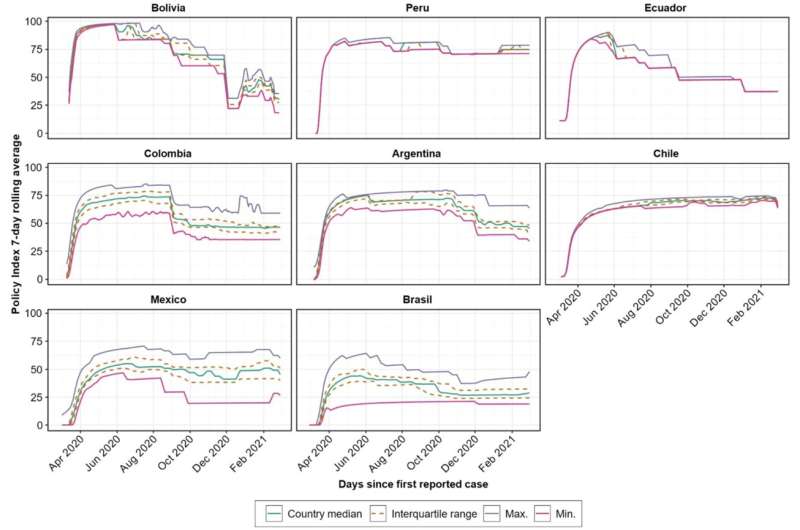
While there’s a strong determination worldwide to return to a new normal in a post-COVID world, the pandemic is nearly impossible to forget. A large amount of data also provides insight we may not want to move past just yet—how we handled it.
UNM Political Science Associate Professor and Chair Jami Nelson-Nuñez is evaluating COVID policies in a research paper titled ” Non-pharmaceutical interventions to combat COVID-19 in the Americas described through daily sub-national data,” published recently in the journal Scientific Data. Throughout the COVID-19 pandemic, she and an international team of researchers investigated the impact of Latin American governments’ actions and plans.
Like in the U.S., politics at national, state and local levels influenced decisions on COVID-19 mitigation around the world impacting cases, deaths, hospitalizations, jobs and education. Nelson-Nuñez specifically looked at the cause and effect of policies and politics in Bolivia through months of data.
“Bolivia is a really interesting case because they have a system that’s mainly decentralized creating a lot of variation across different regions. Our main focus was looking at the effects of policies and how they evolved,” Nelson-Nuñez said. “We were extremely productive on the project and our work shed light on the political intersection of the pandemic in Bolivia and how that spoke to what was happening in several other countries.”
“This tied into what was going on in the United States. It was a deeply political time in our country. These political patterns were reflected across several countries, making for an interesting comparative study,” Nelson-Nuñez said.
The pandemic occurred at a time of upheaval in national politics in Bolivia. After an already tumultuous fall 2019 election, Bolivia’s transitional government lacked legitimacy and the country was deeply divided.
“There was a conflict that had been bubbling for a while. The country was in a moment of crisis of contested leadership. It was interesting to follow how the dynamics of the pandemic in Bolivia were shaped by these political complexities throughout the country,” Nelson-Nuñez said.
When the elections were postponed a second time, tens of thousands of Bolivians across the country rushed to the streets and protested for months. Part of those protests in some places included creating blockades so that medical equipment couldn’t get through.
“Bolivia has always been an outlier when it comes to protest. Its people have always been highly mobilized and able to overcome those collective action problems to mount significant protests,” Nelson-Nuñez said. “There’s a history in Bolivia of people marching for days to the central government and then occupying the streets in the capital.”
With that unrest, non-pharmaceutical interventions (NPIs) were few and far between. A large governmental response given the challenge of already weak state capacity in health services made it difficult to make and enforce coherent policies.
“The central government was trying to figure out how to steer the ship for the whole country, while regional and local actors were contesting these decisions,” Nelson-Nuñez said. “The politics and the dynamics of multi-level governance can render local communities very vulnerable to these types of events.”
Even with the NPIs and guidance issued over time, it was too little too late. The hospital system fully collapsed in the summer of 2020.
Additionally, given the state of leadership, although some NPIs were issued, there needed to be more public trust to abide by government policies and enable governments to make and enforce policies. Her colleagues found similar results in other Latin American countries.
“Underlying disparities in health are political. Underneath health realities are important political factors, and if we ignore those, we really don’t understand how and why pandemics are occurring or why health disparities are emerging in the way that they are,” Nelson-Nuñez said.
Nelson-Nuñez says this research is one of many ways public health and politics are intertwined.
“Sometimes people don’t understand political science. As a discipline, we study power, which means we study resources and the distribution of those resources,” Nelson-Nuñez said. “Health is a resource, and access to services is a resource. We can see political factors across the world that shape the ability of diseases to spread and how deadline global health emergencies can be.”
More information:
Michael Touchton et al, Non-pharmaceutical interventions to combat COVID-19 in the Americas described through daily sub-national data, Scientific Data (2023). DOI: 10.1038/s41597-023-02670-6
Citation:
Research analyzes government intervention and COVID-19 pandemic (2024, April 22)
intervention-covid-pandemic.html
.
. The content is provided for information purposes only.
